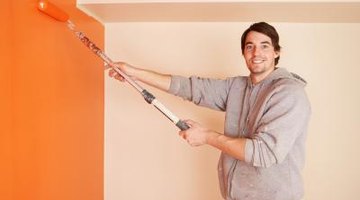How to Avoid Bubbles Using a Paint Roller
Every once in a while, as you roll out paint on your walls, you will see bubbles accumulating on those walls. You don't want to mar your entire job with a few bubbles. Luckily, it does not happen very often. Commercial paint manufacturers frequently include some kind of anti-foaming compound to combat bubbling. Sometimes, though, due to environmental or physical factors, the bubbles appear anyway. There are precautions you can take to keep them at bay and keep your paint job looking pristine.

Step 1
Use a primer coat suitable for the surface you are painting. Often, an unstable paint surface can make the paint bubble as you apply it. There is a comprehensive list at the Resource link below to find what primer to use for your particular surface.
Step 2
Tap the base of the paint can lightly before pouring out the paint. Five or 10 light taps on a solid floor or counter will bring some of the air to the top and out of the paint. Also, drop the can gently from a height of several inches.
Step 3
Use a roller with a low nap. You need thick naps for course surfaces. Cement block or brick requires 1/2 inch or more of nap. You don't need that thick a nap for most interior jobs, though. A 3/8 inch nap is the customary choice for drywall, but if you are getting a lot of bubbles try 1/4 inch. In addition, get a good quality roller. The cheaper ones have less dense fibers. Also, the fibers are more likely to fall off during application. This can increase bubbling and leave unsightly fibers on the wall.
References
Resources
Writer Bio
Bill Brown has been a freelance writer for more than 14 years. Focusing on trade journals covering construction and home topics, his work appears in online and print publications. Brown holds a Master of Arts in liberal arts from St. John's University and is currently based in Houston.
Photo Credits
- Jupiterimages/Photos.com/Getty Images
More Articles



